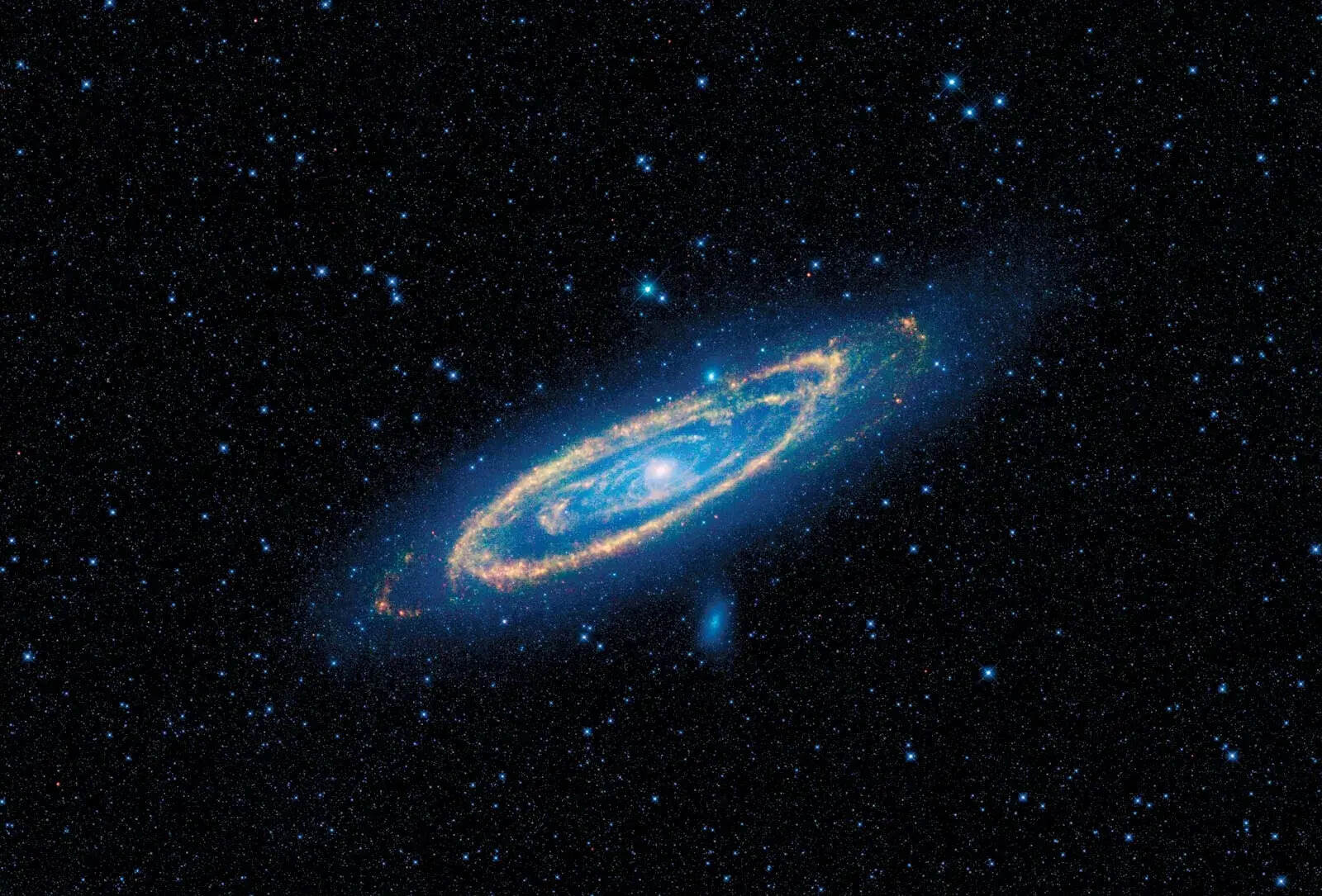
What makes galaxies so fascinating? One key element is galaxy gas, which plays a crucial role in the formation and evolution of galaxies. This gas, found in various phases—cold, warm, and hot—acts as the building blocks for stars and planets. Understanding how galaxies acquire and utilize this gas helps us grasp the intricate processes that shape the cosmos. From the Milky Way's puzzling gas content to the high-velocity clouds in its halo, galaxy gas reveals much about our universe. Dive into these 40 facts to uncover the mysteries and marvels of galaxy gas, and see how it influences everything from star formation to galaxy morphology.
Key Takeaways:
- Galaxy gas comes in three phases: cold, warm, and hot. It's crucial for star formation and is acquired by galaxies through accretion from the intergalactic medium and mergers with other galaxies.
- The Milky Way's gas content is essential for its star formation, but it's surprisingly small. High-velocity clouds in its halo and warm ionized gas contribute to its overall gas budget.
The Basics of Galaxy Gas
Understanding galaxy gas is essential for grasping how galaxies form and evolve. Let's explore the fundamental aspects of galaxy gas, including its composition and the mechanisms through which galaxies acquire it.
-
Composition of Galaxy Gas
Galaxy gas can be divided into three main phases: cold, warm, and hot gas. Cold gas, found in dense regions, is crucial for star formation. Warm gas, with temperatures between 10^4 and 10^5 Kelvin, is more diffuse and harder to detect. Hot gas, exceeding 10^6 Kelvin, is often in galaxy halos and detectable via X-ray emissions. -
Accretion Mechanisms
Galaxies gain gas through accretion from the intergalactic medium (IGM) and mergers with other galaxies. The IGM acts as a gas reservoir, while mergers scatter stars and create new gas reservoirs.
Galaxy Gas in the Milky Way
Our home galaxy, the Milky Way, offers a fascinating case study for understanding galaxy gas. Despite its active star formation, the Milky Way has a surprisingly small gas content.
-
Gas in the Milky Way
The Milky Way's gas content is around 10^9 solar masses, insufficient to sustain its star formation rate for more than a billion years. This suggests ongoing gas accretion from the IGM or other sources. -
High-Velocity Clouds
High-velocity clouds (HVCs) in the Milky Way's halo can supply about 0.1 solar mass of gas per year. Though insufficient alone, they contribute to the galaxy's overall gas budget. -
Warm Ionized Gas
Warm ionized gas, with temperatures around 10^5 Kelvin, is a significant yet challenging-to-detect component of galaxy gas due to its diffuse and ionized nature.
Simulations and Gas Accretion
High-resolution cosmological simulations provide insights into how gas accretion shapes galaxies. These simulations reveal the importance of warm gas in galaxy formation and evolution.
-
Gas Accretion in Simulations
Simulations show that warm gas dominates accretion onto galaxies, playing a crucial role in their early formation stages. -
Temperature History of Accreted Gas
About half of the accreted gas follows a conventional track of shock heating to the virial temperature of the galaxy potential well. The rest can cool and condense to form stars or remain hot. -
Cold and Hot Accretion
Cold accretion involves gas cooling and condensing to form stars, while hot accretion involves gas staying hot, often found in galaxy halos. The balance between these modes affects star formation.
Gas Phases and Cooling
The intergalactic medium (IGM) and radiatively cooled gas within galaxies play vital roles in galaxy formation. Understanding these phases helps explain the complex processes governing galaxy evolution.
-
Gas Phases in the IGM
The IGM contains low-density, highly photoionized gas responsible for the Lyα forest, maintained by adiabatic cooling and photoionization heating. -
Radiatively Cooled Gas
Radiatively cooled gas, a dense phase within galaxies, stays close to equilibrium temperature due to short cooling times, balancing photoionization heating and radiative cooling.
Galaxy Formation and Evolution
The conventional sketch of galaxy formation involves gas transitioning through various phases before forming stars. Simulations and observations help refine our understanding of these processes.
-
Galaxy Formation Sketch
Gas starts in a diffuse phase, enters a shock-heated phase, then cools to form stars. Simulations support this process, showing gas particle distribution in the temperature-overdensity plane. -
Simulation Volumes and Resolution
Simulation volume and resolution affect gas accretion results. Higher resolution provides accurate statistics on cold and hot accretion fractions but introduces numerical effects. -
Mass Resolution Effects
Mass resolution can lower overall gas accretion rates by about 30%. Some gas in lower-resolution simulations may convert into stars within galaxies below the resolution limit.
Galactic Mass and Accretion
The mass of a galaxy influences its gas accretion rates and star formation activity. Smaller galaxies may experience different accretion dynamics compared to larger ones.
-
Galactic Mass and Accretion
Differences in accretion rates between simulations with varying mass resolutions are smaller for smaller galaxies, indicating numerical effects depend on galactic mass. -
Galaxy Gas and Star Formation
Gas availability is crucial for star formation. Galaxies with ample gas reserves sustain high star formation rates, while limited gas supplies reduce or halt star formation.
The Role of Galaxy Gas in Evolution
Galaxy gas significantly impacts the evolution of galaxies, influencing their morphology, structure, and star formation activity.
-
Galaxy Gas and Galaxy Evolution
Gas accretion and distribution shape galaxy morphology and structure, leading to various types like spirals, ellipticals, and irregulars. -
Gas in the Halo
Galaxy halos contain significant amounts of hot and warm gas, detectable through X-ray emissions, essential for understanding the overall gas budget. -
Gas in the Disk
Galaxy disks contain dense, cold gas responsible for star formation, organized into giant molecular clouds that collapse to form new stars.
Gas Accretion and Mergers
Gas accretion rates and galaxy mergers play crucial roles in shaping galaxies, influencing their gas content and star formation activity.
-
Gas Accretion Rates
Gas accretion rates vary depending on galaxy mass and environment. Smaller galaxies may have higher accretion rates due to smaller gravitational potential wells. -
Galaxy Gas and Mergers
Mergers scatter stars and form new gas reservoirs, enhancing the resulting galaxy's gas content and potentially increasing star formation activity.
The Intergalactic Medium (IGM)
The IGM serves as a vast reservoir of gas that galaxies can accrete, influencing their evolution and star formation activity.
-
Gas in the IGM
The IGM contains diffuse, photoionized gas detectable through the Lyα forest, providing a reservoir for galaxy gas accretion. -
Gas Cooling Times
Cooling times for gas within galaxies determine its fate. Cold gas cools rapidly to form stars, while hot gas may remain hot for extended periods.
Dark Matter and Galaxy Gas
Dark matter plays a crucial role in galaxy formation and evolution, influencing gas distribution and accretion through its gravitational effects.
- Galaxy Gas and Dark Matter
Dark matter affects the gravitational potential well of galaxies, influencing gas distribution and accretion. Its presence is inferred indirectly through gravitational effects on stellar motions.
The Milky Way's Gas Content
The Milky Way's halo and disk contain significant amounts of gas, contributing to its star formation activity and overall gas budget.
-
Gas in the Milky Way Halo
The Milky Way's halo contains high-velocity clouds and warm ionized gas, supplying some of the galaxy's gas needs but insufficient for its current star formation rate. -
Gas in the Milky Way Disk
The Milky Way's disk contains dense, cold gas organized into giant molecular clouds, crucial for star formation.
Star Formation and Galaxy Morphology
The availability and distribution of galaxy gas influence star formation rates and galaxy morphology, shaping their evolution.
-
Star Formation Rate
Sufficient gas reserves enable high star formation rates, while limited gas supplies reduce or halt star formation activity. -
Galaxy Morphology
Gas distribution and accretion shape galaxy morphology, leading to various types like spirals, ellipticals, and irregulars.
Galaxy Age, Size, and Shape
Galaxies vary in age, size, and shape, influenced by their formation history and the processes governing their evolution.
-
Galaxy Age
Galaxies range in age from about 500 million to over 13 billion years, influenced by their formation history and evolutionary processes. -
Galaxy Size
Galaxies vary in size from a few hundred to over a million light-years across, influenced by their mass and gravitational potential well. -
Galaxy Shape
Galaxies come in various shapes, including spirals, ellipticals, and irregulars, shaped by their formation history and evolutionary processes.
Supermassive Black Holes and Galaxy Groups
Supermassive black holes and galaxy groups play significant roles in galaxy evolution, influencing gas dynamics and star formation activity.
-
Supermassive Black Holes
Most large galaxies contain supermassive black holes at their centers, with masses billions of times that of the Sun, crucial for galaxy evolution. -
Galaxy Groups
Galaxies often organize into groups of about 10, influencing individual galaxies through gravitational interactions and gas accretion.
The Local Arm and Sun's Orbit
The Local Arm of the Milky Way and the Sun's orbit around the galactic center offer insights into our galaxy's structure and dynamics.
-
Gas in the Local Arm
The Local Arm contains significant gas, including interstellar gas that the Sun is currently surfing, undulating 500 light-years above and below the galactic disk. -
Sun's Orbit
The Sun orbits the galactic center at 515,000 mph (828,000 kph), taking about 230 million years to complete a full orbit.
Galactic Center and Structure
The Milky Way's galactic center and overall structure reveal much about its formation and evolution, including the role of dark matter.
-
Galactic Center
The galactic center contains the supermassive black hole Sagittarius A*, with the Sun about 26,000 light-years away, roughly in the middle of the galactic disk. -
Galactic Structure
The Milky Way has a barred spiral structure with large pivoting arms and a spherical halo of dust and gas twice as wide as the disk. -
Dark Matter Halo
The entire galaxy is embedded in a larger halo of invisible dark matter, making up to 90% of the galaxy's mass, inferred indirectly through gravitational effects on stellar motions.
Galactic Mass and Planetary Systems
The Milky Way's mass and the number of planetary systems within it highlight the vastness and complexity of our galaxy.
-
Galactic Mass
The Milky Way's mass, including dark matter, is around 1.5 trillion solar masses, with visible matter distributed among 200 billion stars, their planets, and massive clouds of dust and gas. -
Planetary Systems
Estimates suggest more than 100 billion planets in the Milky Way, though the exact number of solar systems remains unknown as exploration continues. -
Galaxy Gas and Evolution
Galaxy gas plays a pivotal role in galaxy formation and evolution, influencing star formation, morphology, and overall structure. Understanding its composition, accretion mechanisms, and distribution is crucial for advancing our knowledge of the cosmos.
The Role of Galaxy Gas in Cosmic Evolution
Galaxy gas is essential for understanding how galaxies form and evolve. Composed of cold, warm, and hot phases, this gas fuels star formation and shapes galactic structures. The Milky Way, for instance, relies on gas accretion from the intergalactic medium and mergers to sustain its star formation rate. High-velocity clouds and warm ionized gas in the galaxy's halo contribute to its gas budget, though not sufficiently.
Simulations reveal that warm gas plays a crucial role in galaxy formation, especially in the early stages. The balance between cold and hot accretion influences star formation activity. Additionally, dark matter's gravitational effects impact gas distribution and accretion.
Understanding galaxy gas helps us grasp the complex processes driving galaxy evolution. From the Milky Way's gas dynamics to the broader cosmic picture, galaxy gas remains a key player in the universe's grand narrative.
Frequently Asked Questions
Was this page helpful?
Our commitment to delivering trustworthy and engaging content is at the heart of what we do. Each fact on our site is contributed by real users like you, bringing a wealth of diverse insights and information. To ensure the highest standards of accuracy and reliability, our dedicated editors meticulously review each submission. This process guarantees that the facts we share are not only fascinating but also credible. Trust in our commitment to quality and authenticity as you explore and learn with us.


